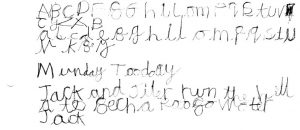
Last week, I talked about how to help your toddler develop pencil and paper skills that are essential for handwriting. Many kids will continue to have very messy handwriting. Parents and teachers will practice with their kids, but will find that the chid may regress again after a short while.
In this post, I will explain three basic strategies that may help address handwriting problems based on my experience of working with younger elementary school children.
Give them a tiny pencil: By tiny I mean an inch to two inches long. You can easily break most pencils or cut them with a knife. You can also use a very small piece of crayon instead. This works for two reasons:
- It will help promote a proper pencil grasp: you really have to use tripod grasp to hold something tiny. So if your child didn’t have a tripod pencil grasp, this is one way of teaching it to them. A proper grasp will improve their pencil control and thereby improve their handwriting.
- It will force them to slow down: because the pencil is so tiny: they’ll be forced to print slowly and take their time and make controlled movements.
Give them paper with bolder lines and wider spaces: and if their notebooks have multiple lines (ex: top, middle and bottom), highlight them with contrasting colours like here. I find that this works immediately almost all the time. There are also two reasons on why this works:
- A lot of the notebooks that I have seen used in schools have very faded lines, and the space between the lines is small as well. This is problematic for kids with developing penmanship and who don’t yet have good control over their pencils. It will be very frustrating for the child to make small, controlled pencil strokes.
- It acts as a strong visual cue: bolder lines are easier to see, and thus will help kids to align their letters to the lines more consistently. A middle dotted line also helps kids have a visual cue to size different lower-case letters.
Teach them to evaluate the neatness of their written output: This sounds like common-sense, but many times, it doesn’t happen, and kids will submit school work that is barley legible. It’s a good idea to establish this as a habit in younger kids, so that the naturally do it when they are older. I always have kids evaluate the neatness of their output in three areas: line alignment, spacing, and sizing. I also ask them to go back and fix what they feel isn’t neat enough.
Does your child struggle with handwriting? I offer comprehensive fine motor and handwriting assessments. I also offer group classes on handwriting and fine motor skil